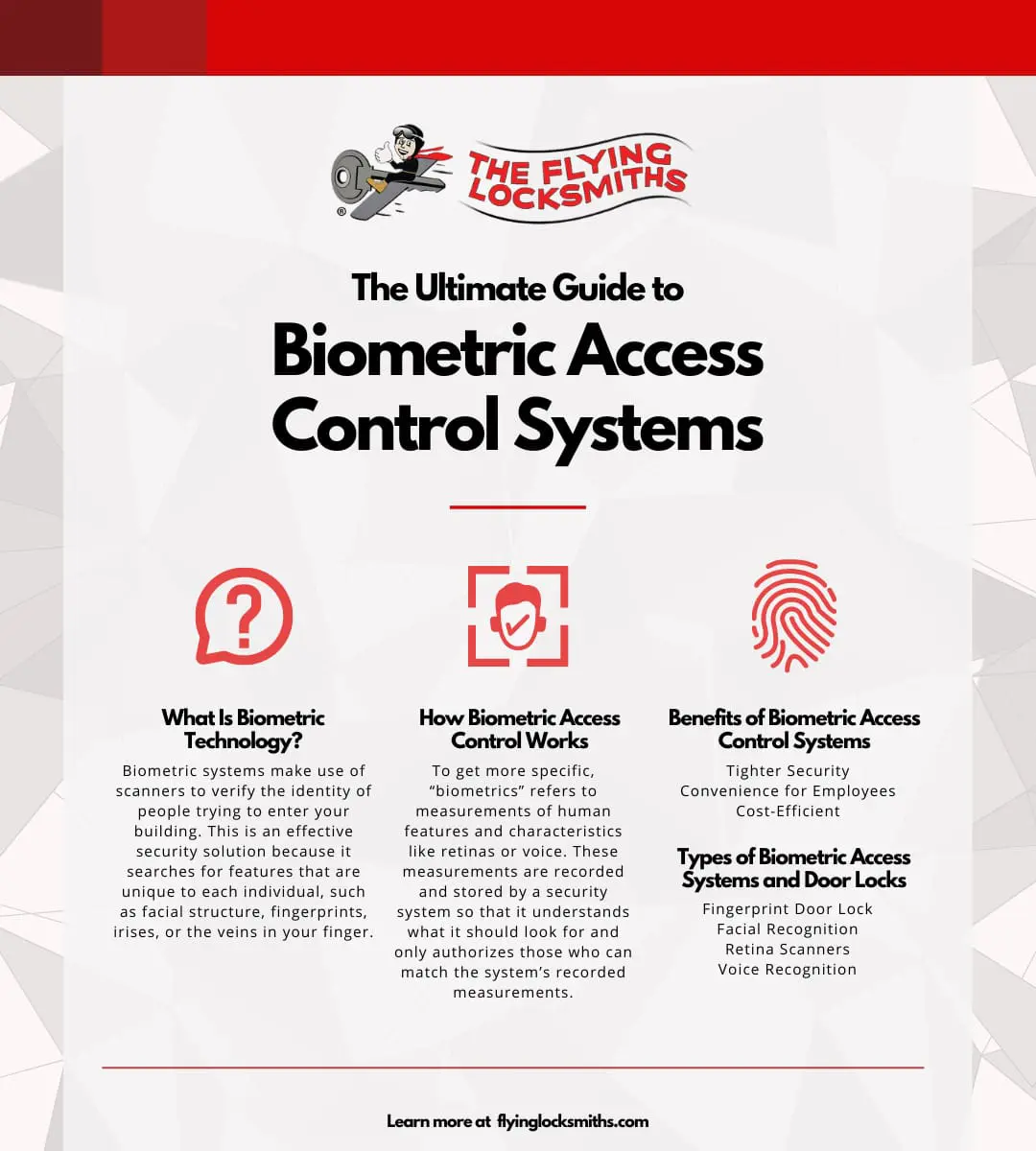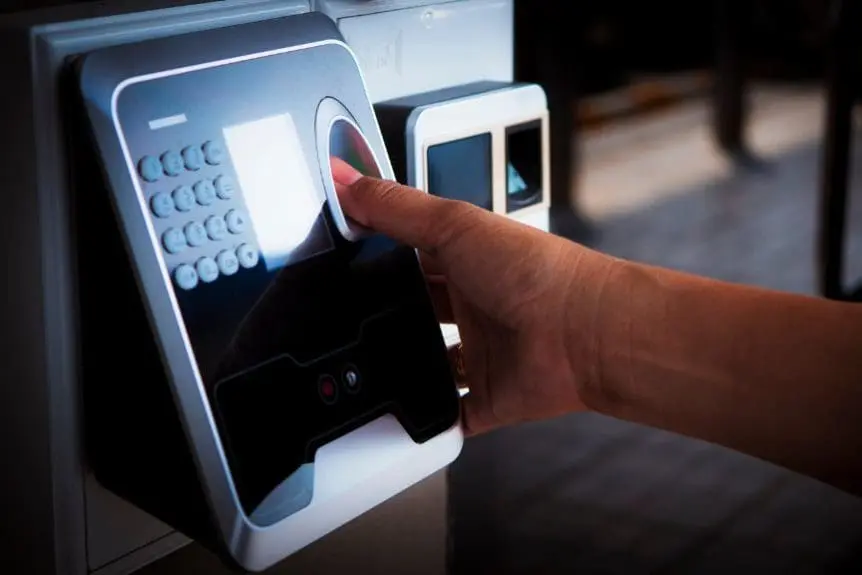
Michael Pecoraro
National Accounts
781.335.3035
Michael.pecoraro@flyinglocksmiths.com
Biometric systems are a long-awaited technology. For years, they were still being improved upon and were not adopted as widely as other security systems. However, with the COVID-19 pandemic creating a demand for contactless services and technology, biometric technology has seen strides in advancements and adoption. If you’re considering access control system installation services, you should read our ultimate guide to biometric access control systems to help you understand why they would be beneficial for your business.
What Is Biometric Technology?
Biometric systems make use of scanners to verify the identity of people trying to enter your building. This is an effective security solution because it searches for features that are unique to each individual, such as facial structure, fingerprints, irises, or the veins in your finger. These features can’t be replicated or misplaced like keys or ID cards. In 2020 alone, during the height of the pandemic, leaders in the technology sector increased their investments in biometric technology by over 50 percent, casting a spotlight on the development of biometric systems and generating greater interest in what used to be considered niche technology.
How Does Biometric Access Control Work?
To get more specific, “biometrics” refers to measurements of human features and characteristics like retinas or voice. These measurements are recorded and stored by a security system so that it understands what it should look for and only authorizes those who can match the system’s recorded measurements. When combined with access control technology, this creates an incredibly robust security system that carefully and easily regulates who can access your building.
Many are hesitant to try biometric systems because they worry it’s monitoring them in some way, but that’s not the case at all. These systems simply store the data that it is given and then look for matching patterns when an individual engages with the system. In fact, biometric systems are more common than you may think, already existing within smartphones to improve security and convenience for their users.
Benefits of Biometric Access Control Systems
So why should your business consider biometric systems over others? Well, let’s take a look at the benefits biometric access control systems can provide that other security solutions cannot. A good biometric access control system is convenient, easy to use, easy to manage, and capable of being scaled for any size company.
Tighter Security
First and foremost, biometric access control systems are far more secure than the use of passwords, PIN codes, or ID cards. The more people who know the password or PIN to your building, the less secure it is because it can easily be leaked or shared with people who aren’t authorized to enter. ID cards and keys, however, can be stolen, lost, or replicated, meaning your employees may not be able to get into the building, and intruders can slip their way in if they can get their hands on a card or key.
In contrast, biometric measurements can’t be easily replicated, nor can they be stolen or lost. With features like fingerprints being completely unique to every individual, your employees become their own key and can easily enter the building while preventing unwanted individuals from getting in. Because biometric access control uses a person’s natural features to identify them, they make for a great first or second layer of security if you want to pair one with another type of security system. It requires little effort on your employee’s part.
Convenience for Employees
Speaking of effort, your employees, management team, and even security personnel will have a much easier time moving in and out of your building as necessary. COVID created the need to minimize contact and the spread of germs, so biometric systems offer a quick, hands-free and straightforward solution that anyone can quickly intuit.
Cost-Efficient
Because they were previously a niche technology, biometric technology has garnered a reputation for being costly. However, with the technology sector investing more into the improvement of biometric technology, they may actually be a more cost-efficient solution for your needs. Not only is the technology becoming more accessible, but for larger firms, printing large quantities of ID cards and other forms of keys can be a running expense that is far more costly in the long run.

Types of Biometric Access Systems and Door Locks
To cap off this guide to biometric access control systems, let’s give you an idea of what solutions you have to pick from.
Fingerprint Door Lock
This is probably the most common biometric access control system. Fingerprints are diverse, and no two are alike, so it’s easy to ensure that only your employees are authorized and capable of entering your building. And, of course, because you’re reaching for the door handle already, it’s easy and convenient to scan your thumb first over other features like your retinas. Quick, easy, and elegant, the only aspect that may not make fingerprint locks ideal is if you desire a completely contactless solution.
Facial Recognition
Facial recognition is also common and captures unique aspects of a person’s face to form a pattern that can be matched. Such systems can be extremely accurate but require adequate lighting to ensure faces are not obscured from the system.
Because people change over time through age, injury, and more, facial recognition can falter, but as it becomes smarter and more advanced, such issues have become minimal. Facial recognition software maintains a consistent track record of being incredibly effective and creates a completely contactless solution.
Retina Scanners
Alternatively, eyes do not change, so a retina or iris scanner may be preferred if you’re worried about a full facial solution faltering. The trade-off is that retina scanners may be less convenient or more difficult to use if your employees need to be in a certain position for the retina scanner to function.
Voice Recognition
Finally, voice recognition software records and identifies distinct characteristics of a person’s voice. Voice recognition software is more commonly used for authentication applications to prove your identity on customer service calls or in financial institutions. However, it’s still plenty applicable for access control and is another good solution that is completely contactless.
Get in contact with Flying Locksmiths today to inquire further about biometric access control systems or any of our other access control system installation services! Our experts are well versed in the latest door security system technology and techniques, so you can rest assured you’ll be receiving the best solutions and service possible.


